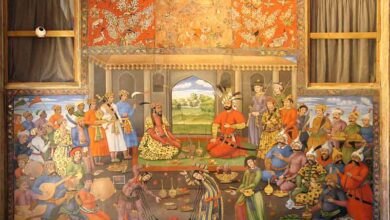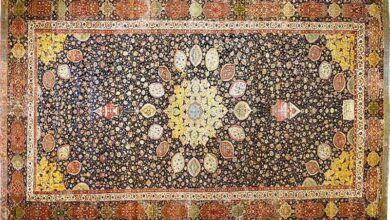Art as Architecture or Architecture as Art

Bruce Allsopp, an expert on architecture and its history, gives a simple definition of architecture: Architecture is a building that has meaning and content.
He believes that architecture refers to a type of construction through which people realize their identity and give meaning to this identity.
Bruce Allsoop also states in the definition of architecture: Architecture requires man to use his common feelings as a means of expressing common feelings.
“Architecture is just the creation of new types of spaces,” said Philip Johnson, another architectural expert in his definition of architecture. He considers the most important role of architecture to create change in the existing cultural context and this is the first role of aesthetics.
Frank Ching: Architecture as an art is more than just meeting the functional needs of a building. In principle, the physical manifestations of architecture correspond to human function.
Dr. Mehdi Hojjat has also stated in the definition of architecture as follows: Architecture is shaping the place of human life. Thus, the act of architecture requires the simultaneous attention to two factors: “shape” and “life”, in other words, architecture seeks to make a container for the object. A container called a building for the subject of “human life”.
Christoph Alexander also gives a simple definition of architecture: Every human being knows his life because he is a human being. It is enough to pay attention to it and be honest with oneself and let what is inside it take the form of wood, stone and shape the place of living.
Walter Gropius: From the table spoon to the city, it defines the scope of the architect’s work.
Eentienne-Louis Boullée: What is architecture? Is architecture the art of construction? Certainly not.
Tadao Ando: Architecture must be in perfect harmony with the surroundings.
Francisco Milesia: Architecture is the art of making.
Twivaito: Architecture is an urban phenomenon.
Romantics: Architecture is an independent art.
Futurists: Architecture is influenced by the mechanical world and technology.
Le Corbusier: Architecture is more than a show of construction and responding to needs.
John Ruskin: Architecture is the art of arranging and decorating man-made structures for any purpose in such a way as to provide the health, strength, and enjoyment of the soul at its simplest.
Snowa: Ladowski’s ideology of constructivism was introduced in such a way that architecture should be a combination of three factors: technical straightforwardness, economic feasibility, and visual expression.
Le Bene Voleh: Modern architecture was born of technical, social and cultural changes resulting from the Industrial Revolution.
Christian Nurberg Schultz: We may conclude that the attribute of architectural perfection depends on three basic criteria: the role of the building, the shape and the techniques.
Hollain: Everyone is an architect and everything is architecture.
Adolf Luce: Architecture is nothing but monuments and tombs.
Le Corbusier: The architecture of the game is under the light.
Modernists: Architecture is an industry.
Eisenman: Our architecture today should reflect our mental and biological condition, and what has been neglected in our architecture today is part of our lives.
Walter Gropius: Architecture is an applied art and is formed in close connection with other arts, and a clear example of this definition is the Bauhaus school.
Antoni Gaudí: Architecture is a return to nature and the environment.
Charles Jenks: Architecture is not a matter of words and letters and can not be expressed in most words.
William Morris: Architecture encompasses the entire physical environment that surrounds human life, and as long as we are part of civilized society we cannot go beyond it because architecture is a set of positive changes and transformations that are in line with human needs on Earth. It has been created and only the untouched deserts are an exception.
Flaubert: Architects are all stupid, they always forget the stairs.
Bahram Shirdel: Architecture is not art, architecture is science and should serve society.
Sullivan: Architecture is not a simple art that can be relatively successful in creating, but a social manifestation.
Vitor Vius: The first person to say that architecture is art.
Robert Venturi: Architecture is not just a technique and technology, but there are very complex and contradictory issues in the building that can not be ignored.
August Pere: Living architecture is the true representative of its time. In all realms of construction we look for it and from among them we choose works that are hardly subordinated to the expected use, made with wise materials and achieved with the appropriate combination of essential elements. To be.
In general and briefly in the definition of optimal architecture can be said:
Optimal architecture is architecture in which human beings feel alive and well, cohesive and relaxed.
Architect:
To define an architect, we also use the definitions of architectural experts. In this regard, and in the definition of the architect, Christopher Alexander has stated: An architect in the general sense is someone who builds a building. In building this building, he must not only know the characteristics of the kind of life that is to take place in that place. He should also be aware of the image of a better life in that place.
Therefore, the architect inevitably expresses his perception of a better life in the place he designs. In this way, the architect’s set of beliefs is manifested, which is the product of his understanding and feeling of the most worthy life that can be offered in the designed place. The architect is also known to provide a definition of the most worthy life. By creating its own architectural space, it provides users with the possibility of realizing it.
Origin of Architecture:
From the earliest days of human cultivation and domestication of cattle, tribes settled around the Mediterranean Sea. Life, myths and motifs carved by prehistoric man laid the foundation of Western civilization.
These tribes evolved as they emerged from the darkness of ignorance and as their homes and temples became increasingly complex to reflect their lives. Their simple ancestral buildings were replaced by newly designed buildings.
The stone temples and tombs of the age, in terms of shape, sculpture, painting and decoration, are often built to imitate the new houses of the first farmers who lived along the Nile. Even today, similar houses can be seen in the villages on the southern shores of Mesopotamia.
In the ninth century BC, baked clay buildings near Corinth in Greece were presented to the goddess Hera.
In the 7th century BC, Latin tribes living in the hills where the city of Rome was later built buried the ashes of their dead in small mud huts. Buildings like these are still built in the lands where classical architecture emerged with local materials as housing for nomadic shepherds. To this day, these buildings are used as permanent buildings in the poorer countries of the world.
In ancient times, rural houses were not only considered as permanent monuments of ancestral stone temples. But until the first century AD. Ancient thatched temples were revered in Athens and Rome. The influence of the first ancient heritage remains during the long history of classical architecture. Each classical building is an example of a primitive cottage, and the use of classical architecture is a living proof of the cultural origins of Western civilization.
Architecture in Egypt:
The basis of Western monumental architecture has been in Egypt. At the time of the first signs of civilization in Greece, Egyptian architects had built a huge and heavy building fifteen centuries earlier.
The very fertile soil around the Nile River and the exploitation of this resource led to the emergence of a rich civilization.
The fascination with eternity and the creation of sustainable life dominated ancient architecture. Royal tombs were temples for the worship of the deceased pharaohs. Around 2800 BC, artificial mountains of stone or pyramids were built on rooms that housed the completely mummified body of Pharaoh and his valuables.
The pyramids were the first major monuments in the world to be made of stone. Bloody Temple in Karnak. The special features of Egyptian architecture had a strong influence on the development of the classical style and some of its architectural details influenced Roman architecture. None of the Egyptian architectural styles developed abroad. Because the Egyptian architectural style was too specific and too conservative and inflexible to adapt to the needs of the poorer cultures around it.
The Treasury of Atreus dates back to about 1300 BC from the Greek civilization and the temple built on Perinias by the Greeks six hundred years later in Crete; It shows the difference between progress and comparable backwardness of its northern neighbors. The adaptation of the facades of important buildings with stone, the use of columns and stone beams for temples and the eagerness to build a large and majestic building should be considered as the most important contribution of Egyptian architecture in the mainstream of the classical school.
Architecture in Greece 700 BC-200 BC
Greek governments took advantage of their position along the Mediterranean Sea and valuable Mediterranean trade routes. And around 700 BC, they united ideologically and not in terms of government, in which freedom of thought along with internal competition led to the emergence of an intellectual and artistic revolution.
The rise of Greek civilization threw the Western world into a political, intellectual and artistic current. Which carried it forward for 2,500 years. However, with the advent of rational thought, our gods destroyed the pre-civilization that the Greeks had from a distant and dark past, and the houses built for them became examples and standards for Western architecture.
A new design of the temple emerged from the brick and mud buildings. The first temples had flat mud roofs or thatched roofs. In the 8th century BC, the invention of large clay pieces of the roof; He made a plan in the shape of a simple rectangle with a short, triangular roof, which is characteristic of classical buildings.
Ancient Greek architects worked for more than two centuries to perfect only one type of building. And in this regard, they created a kind of architecture that, with the help of its lasting power and capacity, remained as the ideal of the world for more than two thousand years.
Famous buildings of this period include the Temple of Apollo in Greece in 630 BC, which rested on wooden beams and whose original form remained as a model for all major temples for the next century; And the Temple of Artemis at Kozfu, where the apparent presence of a wooden structure turned to a stone structure.
When the Greeks overthrew the Persian Empire in the middle of the fifth century BC, their privileged civilization displayed its intellect and wisdom concentrated in a century full of wealth and power. Literature, art, and philosophy flourished, and its new buildings displayed a level of elegance whose components, as role models, influenced all future developments in Western architecture.
At the same time that the Greek city-states were experiencing a brief period of prosperity and prosperity, they created a kind of architecture for their future that we call classical.
Architecture in the Roman Empire: 200 BC – 1200 AD
About 200 BC, the city armies of Rome and its Italian allies defeated the Greeks and advanced due to the weakness of Alexander’s empire. The second expansionism made this land the center of civilization and luxury. Simultaneously with the formation of the Second Absolute Empire in the first century BC, the use of volcanic rocks with lime revolutionized the construction of buildings and transformed classical architecture.
Roman architects modified the architectural system they borrowed from Greece to use the new material.
The emperors inherited a democratic obligation to maintain buildings and maintain their popularity in Rome. The wealth of the empire allowed successive emperors to build large buildings to entertain the people and beautify the cities.
Perhaps the most famous of these is the Colosseum, which was built in 70 AD by the emperor and the Sepasians. This huge building had a capacity of 50,000 (50,000) spectators for the brutal entertainment in the amphitheater.
There were also the baths of the Emperor of Caracalla in 216 AD with a capacity of 1,600 people; He named the Temple of the Gods in the Pantheon in 120 AD, which gives us the most complete picture of the great buildings of the empire.
Byzantine “Eastern Rome”
When the Roman Empire in the West finally landed against the invaders in 476; The emblem of the empire was sent to the Eastern Byzantine emperor “Eastern Rome”. The Byzantines considered themselves the successors of the first Roman emperor. And if geographical scope is not taken into account, Byzantine architecture is a direct continuation of the classical tradition. The war on the eastern frontiers prevented the eastern emperors from reuniting the territories of the empire. But in 532, the Justinian Empire signed a treaty with the Persians, freeing its troops to reconquer the lost states in Africa and even Rome.
The invasion of the Berbers in the west and the rise of Islam in the east turned the victory force into a long retreat, but during the next 9 centuries the Justinian majesty in the form of small buildings such as the brick building of the dome of the Church of the Holy Apostle in Thessaloniki in 1315 Stayed and continued.
Other famous monuments of this period include the largest building of the Eastern Hagia Sophia in Istanbul, the Church of St. Demetrius in Thessalonica at 475, decorated with capitals.
When the last Roman Empire left Istanbul in 1453, classical Byzantine architecture came to an end, but its legacy continued in Eastern European buildings and even in Ottoman buildings.
Result:
A distinction must be made between architecture and the art of architecture, which are two completely separate concepts. In architecture, construction means in order to perform social duty and service. Such as building residential, places of worship or education. But in the art of architecture, the emphasis is on the use of artistic masterpieces and decorative achievements on walls, ceilings, columns, windows and doors, and even gardens and ponds are combined with the art of architecture to increase the impact on the viewer.
* Sources and references are available in the editorial office of Artmag.











